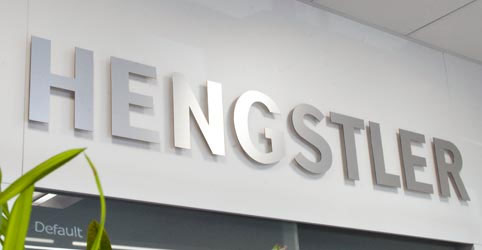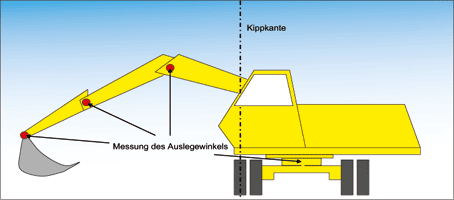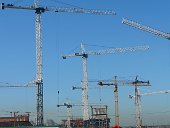
Hengstler, Aldingen. Modern construction machinery being predominantly controlled and moved by hydraulic systems, electronics and control technologies so far only have played a minor role in many applications. However, safety-relevant aspects and driver-assisting functions have started to set the stage: sensors, such as encoders or potentiometers, are increasingly being used to provide the control unit with positioning, angular and speed data. In this segment, very high standards are demanded of sensors. Outdoor operation is subject to varying climatic conditions, i.e. extreme temperature fluctuations and the influence of dirt, dust and liquids. The resulting requirements for high ruggedness and a high degree of protection have formed the basis of Hengstler’s newly designed encoder families.
Encoders are used for positioning, angular, speed and length measurements in construction machinery applications. They assume tasks that facilitate the driver’s work and enhance productivity, such as, for example, straight-to-the-point positioning of loads for hoisting equipment, or restricting work zones in order to protect against collisions. However, they also allow introducing safety-relevant functions, giving warning signals to the driver as soon as the machine enters into a critical situation. Excessive loads causing hoisting equipment (hoisting cranes, excavators) to tilt present a classical example.
In agricultural and forestry machine applications too, encoders make the work significantly easier by automating the processes of many applications, starting from speed-controlled sowing in agriculture right through to automated measuring of tree trunks. Automated processes that increase productivity in agriculture are becoming more and more sophisticated through the use of satellite-controlled systems. And finally, special machinery is used for rail-track maintenance, positioning of grinding wheels, for mining and drilling technology (control of drilling speed), as well as for special transport equipment for oversized objects, where they determine the steering position of each wheel.
In summary, encoders used in construction equipment always prove their capabilities under extremely harsh conditions by providing reliable feedback on the positioning, excursion angles or speeds. The robust encoder families made by Hengstler convince by their technology, which is completely free from sliding contacts and ensures high reliability and longevity. The programmable absolute encoder types, in particular, do not necessitate any re-adjustment as compared to other technology products. Proper function and accuracy of potentiometers, for example, are adversely affected by temperature fluctuations and wear and tear. In addition, encoders offer full 360° scanning, which allows obtaining accurate feedback over a full turn or even several turns. Multiturn versions make it possible to read the exact number of turns at any time, even after voltage drops or complete power failures.
As already mentioned, encoders lend themselves to a great variety of construction equipment applications. Let us explain their use based on an example from the field of hoisting machinery, such as hoisting cranes and hydraulic excavators. First of all, machinery manufacturers have several good reasons to use reliable sensors: legal requirements for the prevention of accidents or registration of vehicles for road traffic are important criteria; achieving increased productivity in the daily work is another one.
According to the German Directive concerning the prevention of accidents (VBG 40), an overload warning device is required both for crane systems and hydraulic excavators. It has to give the driver a warning signal as soon as the permissible load is exceeded. For hydraulic excavators, this can be implemented by means of a measuring element that determines the operating pressure in the cantilever (jib) cylinder and transmits a warning signal to the driver as soon as a defined pressure is exceeded. This function can be assumed by encoders and even supplemented by providing feedback to the control system. By determining the angle of excursion of each rotating axis of the excavator arm and the slewing ring between the upper and lower trolley, the maximum permissible load in the excavator bucket or crane suspension can be calculated at any time. The appropriate load moment for each position can be entered via the software, thus assisting the driver with warning signals or even active interference with the motor control.

Restricting the work zone to protect against collisions:
Construction work often has to be carried out in confined areas, e.g. close to electrical overhead power lines or on sites where several hoisting cranes may impede each other, or in pedestrian zones. Such hoisting equipment as hydraulic excavators, for example, may be used in buildings with restricted ceiling height, or mobile cranes in railway loading stations with overhead power lines. In such cases, crane systems use a so-called electronic safety working range (in German: ABB). An electronic control system protects against obstacles by decelerating the crane when it comes too close to an obstacle and thus, prevents it from colliding with it. Anti-collision systems are also used for large construction sites with several cranes. They monitor each crane position and reliably prevent them from getting too close to the neighboring crane. Following the principle described above, encoders determine the exact position and excursion angle of the machine and transmit it to the control electronics.

The work of crane operators will be so much easier if loads are positioned straight to the point. To achieve this, an encoder continuously provides feedback to the control unit on the position and speed of the crane. Set points can thus be selected by means of micro-fine turning adjustments, and the effects caused by the prevalent wind or load conditions compensated by means of the appropriate counter-movements.
Hydraulic wheel excavators will be approved for road traffic if they are provided with a sensor ensuring that the upper trolley is aligned in the driving direction. Inductive sensors are very frequently used for this purpose. However, new possibilities plus the functions described above can now be implemented by providing an encoder in the rim between the upper and lower trolley.
The essential technical requirements for using encoders in construction equipment include a high degree of protection, wide temperature range, high shock and vibration resistance, high resistance to water and humidity, as well as high load resistance of the shaft. Encoders should exhibit protection degree IP67 or even IP69. A temperature range extending from -40°C to 100°C ensures perfect operation under harsh environmental conditions, such as direct exposure to sunlight and fluctuating temperatures. To prevent water condensate caused by internal heating and cooling phases, the enclosure should be specifically sealed. The shock resistance varies depending on the application, but should be 1,000m/s2 minimum; the vibration resistance should be 100m/s2 minimum. Since construction equipment is often cleaned by means of steam-jet cleaners, high resistance to compressed water is also of great importance.
With its “Heavy Duty” product family, Hengstler offers the suitable encoders (HSDxx, HDxx, ARxx) to meet or even surpass all these requirements. Extremely high mechanical ruggedness, for example, is achieved by using a state-of-the-art optoasic and coding disk made of plastic instead of the common glass type, which may break under extreme load conditions. This product series is also available with stainless-steel enclosure according to NEMA 4x and 6P with double sealing, ensuring reliable operation in environments that require high resistance to high-pressure steam cleaners or corrosive chemicals. Encoder types HSDxx nd HDxx are intrinsincally safe variants and, when used with the appropriate IS barrier, certified according to ATEX EEx ia IIB T4. This makes them suitable for applications in corrosive atmospheres or applications requiring high resistance to splash and surge water.
Hengstler offers another extremely rugged product family with its magnetic encoder series AR-XX. Its special features not only include a particularly rugged enclosure, but also generously dimensioned self-contained ball bearings, thus making it resistant to high mechanical stresses and even high axial and radial forces. 12-bit resolution allows highest acceleration rates and underwater operation. All products are electrically compatible with standard encoders and available with the common interface types (SSI, BiSS, CANopen, analog or parallel).
Rugged technologies make it easier for electronic components to enter and become established in the field of construction equipment. They also respond to the requirements for high safety, productivity and operator convenience. Even if it might take another few years for electronics to replace hydraulics, already now it is obvious that the role of sensor technology will become increasingly important.